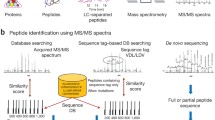Abstract
The degradome microarray – CLIP-CHIP™ – is a dedicated and focused array that allows the analysis of all proteases, non-proteolytic homologs, and protease inhibitor gene transcripts in the human and murine genomes at the mRNA transcript level.
Based on unique 70-mer oligonucleotides, designed to match parts of the sequence of known or predicted protease and inhibitor mRNAs in both species and printed on a glass-matrix surface, the CLIP-CHIP™ microarray can be used to analyze differentially expressed protease and inhibitor gene products and give expression profiles for any analyzed sample.
Access this chapter
Tax calculation will be finalised at checkout
Purchases are for personal use only
Similar content being viewed by others
References
Overall, C. M., Tam, E. M., Kappelhoff, R., Connor, A., Ewart, T., Morrison, C. J., Puente, X., Lopez-Otin, C., and Seth, A. (2004) Protease degradomics: mass spectrometry discovery of protease substrates and the CLIP-CHIP, a dedicated DNA microarray of all human proteases and inhibitors. Biol Chem 385 (6), 493–504.
Barrat, A. J., Rawlings, N. D., and Woessner, J. F. (eds.) (1998) Handbook of proteolytic enzymes. Academic Press, New York.
Puente, X. S., Sanchez, L. M., Overall, C. M., and Lopez-Otin, C. (2003) Human and mouse proteases: a comparative genomic approach. Nat Rev Genet 4(7), 544–558.
Saeed, A. I., Sharov, V., White, J., Li, J., Liang, W., Bhagabati, N., Braisted, J., Klapa, M., Currier, T., Thiagarajan, M., Sturn, A., Snuffin, M., Rezantsev, A., Popov, D., Ryltsov, A., Kostukovich, E., Borisovsky, I., Liu, Z., Vinsavich, A., Trush, V., and Quackenbush, J. (2003) TM4: a free, open-source system for microarray data management and analysis. Biotechniques 34(2), 374–378.
Rainer, J., Sanchez-Cabo, F., Stocker, G., Sturn, A., and Trajanoski, Z. (2006) CARMAweb: comprehensive R- and bioconductor-based web service for microarray data analysis. Nucleic Acids Res 34, W498–W503.
Hokamp, K., Roche, F. M., Acab, M., Rousseau, M. E., Kuo, B., Goode, D., Aeschliman, D., Bryan, J., Babiuk, L. A., Hancock, R. E., and Brinkman, F. S. (2004) ArrayPipe: a flexible processing pipeline for microarray data. Nucleic Acids Res 32, W457–W459.
Li, Y., Li, T., Liu, S., Qiu, M., Han, Z., Jiang, Z., Li, R., Ying, K., Xie, Y., and Mao, Y. (2004) Systematic comparison of the fidelity of aRNA, mRNA and T-RNA on gene expression profiling using cDNA microarray. J Biotechnology 107(1), 19–28.
Feldman, A. J., Costouros, N. G., Wang, E., Qian, M., Marincola, F. M., Alexander, H. R., and Libutti, S. K. (2002) Advantages of mRNA amplification for microarray analysis. Biotechniques 33(4), 906–914.
Polacek, D. C., Passerini, A. G., Shi, C., Francesco, N. M., Manduchi, E., Grant, G. R., Powell, S., Bischof, H., Winkler, H., Stoeckert, C. J. Jr., and Davies, P. F. (2003) Fidelity of enhanced sensitivity of differential transcription profiles following linear amplification of nanogram amounts of endothelial mRNA. Physiol Genomics 13, 147–156.
Kacharmina, J. E., Crino, P. B., and Eberwine, J. (1999) Preparation of cDNA from single cells and subcellular regions. Methods Enzymol 300, 3–18.
Pabon, C., Modrusan, Z., Ruvolo, M. V., Coleman, I. M., Daniel, S., Yue, H., and Arnold, L. J. Jr. (2001) Optimized T7 amplification system for microarray analysis. Biotechniques 31(4), 874–879.
Van Gelder, R. N., von Xastrow, M. E., Yool, A., Dement, D. C., Barchas, J. D., and Eberwine, J. H. (1990) Amplified RNA synthesized from limited quantities of heterogeneous cDNA. Proc Natl Acad Sci U S A 87, 1663–1667.
Ritchie, M. E., Silver, J., Oshlack, A., Holmes, M., Diyagama, D., Holloway, A., and Smyth, G. K. (2007) A comparison of background correction methods for two-colour microarrays. Bioinformatics 23(20), 2700–2707.
Smyth, G. K. and Speed, T. (2003) Normalization of cDNA microarray data. Methods 31(4), 265–273.
Yang, Y. H. and Thorne, N. P. (2003) Normalization for two-color cDNA microarray data. In Goldstein D. R. (ed.), Science and Statistics: A Festschrift for Terry Speed, IMS Lecture Notes – Monograph Series, 40, 403–418.
Tusher, V. G., Tibshirani, R., and Chu, G. (2001) Significance analysis of microarrays applied to the ionizing radiation response. Proc Natl Acad Sci U S A 98(9), 5116–5121.
Luo, L., Salunga, R. C., Guo, H., Bittner, A., Joy, K. C., Galindo, J. E., Xiao, H., Rogers, K. E., Wan, J. S., Jackson, M. R., and Erlander, M. G. (1999) Gene expression profiles of laser-captured adjacent neuronal subtypes. Nature Med 5(1), 117–122.
Acknowledgements
Christopher M. Overall is supported by a Canada Research Chair in Metalloproteinase Proteomics and Systems Biology, by research grants from the National Cancer Institute of Canada (with funds raised by the Canadian Cancer Association) and from the Canadian Breast Cancer Research Alliance Special Program Grant on Metastasis, and by a Centre Grant from the Michael Smith Research Foundation. Ulrich auf dem Keller is supported by a research fellowship of the Deutsche Forschungsgemeinschaft Germany.
Author information
Authors and Affiliations
Editor information
Editors and Affiliations
Rights and permissions
Copyright information
© 2010 Humana Press, a part of Springer Science+Business Media, LLC
About this protocol
Cite this protocol
Kappelhoff, R., auf dem Keller, U., Overall, C.M. (2010). Analysis of the Degradome with the CLIP-CHIP™ Microarray. In: Clark, I. (eds) Matrix Metalloproteinase Protocols. Methods in Molecular Biology, vol 622. Humana Press, Totowa, NJ. https://doi.org/10.1007/978-1-60327-299-5_10
Download citation
DOI: https://doi.org/10.1007/978-1-60327-299-5_10
Published:
Publisher Name: Humana Press, Totowa, NJ
Print ISBN: 978-1-60327-298-8
Online ISBN: 978-1-60327-299-5
eBook Packages: Springer Protocols




